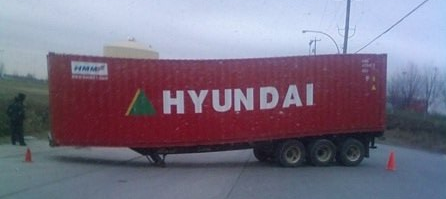Hooking to a semi-trailer – how to hook up a tractor trailer
December 31, 2014
All too often, semi-trailers are dropped on the ground incurring considerable time & expense. A crane or large forklift first has to be found, brought to the site and used to pick up the trailer and hold it while the tractor backs under. Worse yet, the trailer falls off the back of the truck when it’s going down the road, risking the lives of other road users.
Trailer “Hook-up” or “Coupling” – Simplified
Back up to the trailer and stop – just as the 5th wheel touches the trailer – apply the parking brakes
1. Get out and check that the height of the 5th wheel matches that of the trailer
2. Confirm that the handle is out and the 5th wheel locking dogs are locked
3. Back under the trailer
4. Check the 5th wheel
a. Handle is in (position when 5th wheel jaws are in the locked position)
b. There is no “day” light or space between the 5th wheel and the trailer
c. The 5th wheel jaws are locked behind the trailer king pin (use a flashlight)
5. Wind up the trailer landing gear an inch
6. Conduct a tug test to confirm that the 5th wheel is locked to the king pin
7. Finish winding up the landing gear (all the way)
8. Attach the air lines & electrical chord
9. Climb into the cab and roll down the window (to hear brakes work and/or any leaks)
10. Conduct a tug test with the trailer parking brakes “still” engaged – the trailer should not move – ensure that you release the tractor parking brakes beforehand
11. Push in the trailer supply valve
12. If it’s a new trailer, conduct a pre-trip inspection on the trailer …
13.Actuate the hand valve (spike) 2 or 3 times and listen for air exhausting from the trailer – this preliminary check indicates that the trailer service brakes are working
14.Roll ahead a few feet and activate the hand valve again to ensure that the trailer service brakes engage independently of the tractor and so in fact bring the unit to a stop

What could potentially go wrong
A veteran error: If you don’t stop and check the height of the trailer before backing under it, at some point the trailer will be too high. Consequently, the king pin will drop over the front of the 5thwheel, and believe me, it is a pain to fix this and often requires two people and a length of 2×4 to pry down the front of the 5th wheel.
Risk of dropping the trailer on the ground increases exponentially if you don’t thoroughly check all components of the 5th wheel after backing under the trailer
Always wind up the landing gear before hooking on the lines – if you hook up the lines and forget to wind up the landing gear, you look like an amateur when you drag the landing gear across the yard.
If you wind up the landing gear and forget to hook up the lines, you’re not going to look amateur because the unit won’t move, and to rectify the problem you simply hook up the lines
Finally, by checking the 5th wheel connection visually in combination with a tug test, you can be sure that the only way the trailer will inadvertently come unhooked is through mechanical failure
Last, on all new trailers a driver should conduct a test to ensure that both the trailer service and parking brakes are operable and will stop or hold the unit
Summary
- Back up to the trailer – stop just as the 5th wheel touches
- Check that the release handle is out, the locking dogs are locked and the height is correct
- Back under – check jaws are lock behind the king pin
- Wind up the landing gear – an inch – for a tug test
- Wind up the landing gear – all the way – for departure
- Hook up the airlines and electrical chord
- Conduct a pre-trip inspection and brake test (both service & parking)
Hooking a trailer to a tractor is simple after some repetition, and if done in the above order with the proper checks. If the order is changed or the checks are not conducted, a trailer will likely end up on the ground at some point during your career. In the “real world of trucking” this procedure should take less than 5 minutes. These precious minutes could potentially save you hours of grief and a reputation that will persist throughout your career.





